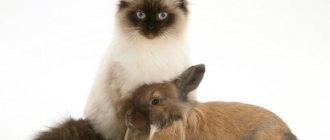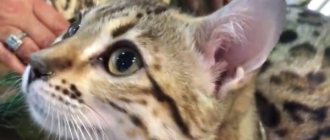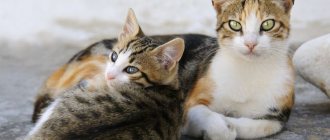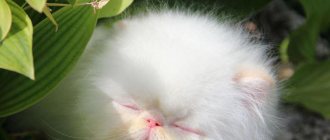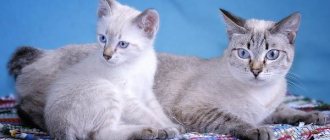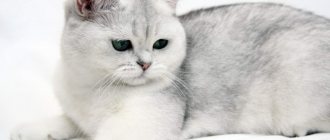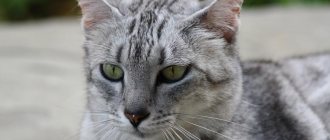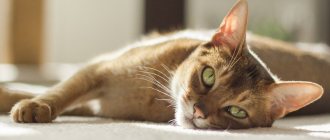Description and features
The desire to have an elf with a short tail at home is quite feasible, because this is how “pixie-bob” is translated from English. Therefore, all you need to do is turn your attention to the breed of cats with that name. Such pets make ideal companions: self-sufficient, discreet, affable, friendly and loyal.
The pixie bob boasts an original appearance, having clear similarities with the North American lynx. Actually, this is what the breed was intended to be by breeders, who painstakingly bred it with exactly these characteristics. And therefore, cats of this breed are distinguished by:
- massive body;
- strong large paws;
- short, low-set tail;
- coat marked with medium-sized and small spots;
- sideburns that complete the look of a lynx;
- in some cases, tassels on the ears.
The pixie bob's head is pear-shaped with a wide muzzle and a powerful chin. It has rounded ears at the ends, slightly tilted forward. The deep-set eyes of such cats have heavy eyelids. The color of the iris at birth is blue. But after six months it changes its color to green, brown or golden.
The nose of the representatives of the breed is brick in color, slightly humped, and wide; paw pads are dark; the tip of the tail is black or chocolate; The dark whiskers at the base may be white at the tips. According to the standards, a larger number of toes than usual is acceptable.
Pixiebobs are incomparable in size to wild lynxes; they are much smaller. As for cats, that is, the female half, even in adulthood they rarely reach a weight of more than 5 kg. But cats in this respect differ from their other brothers.
The pixie bob breed was created by crossing a forest cat with a domestic cat.
If males of other breeds, reaching the age of one year, practically stop their growth, male domestic lynxes develop and increase in size up to 4 years, and their body at the end of adulthood may well reach a ten-kilogram mass.
Kinds
looks attractive in the photo The breed itself is divided into two varieties, because its representatives come with short and long hair. However, according to standards, hair dimensions, even in special cases, should not exceed 5 cm.
Shorthaired cats have thick, straight hair. The fur on the belly is slightly longer than on other parts of the body. Its structure is fluffy and soft. In long-haired representatives of the breed, the hair lies along the body. But these are not all the differences between house elves.
The color of the pussies of this breed is characterized by brown, reddish, red, mouse tones with light tips of the hairs. Accordingly, pixie bobs come in a variety of colors. These shades are subject to seasonal changes.
Cats of this breed are distinguished by their tabby color. Its signs include: the scarab sign, that is, a dark, clear mark on the forehead in the form of the letter “M”; dark stripes on the chest, resembling necklaces in outline; rings in the form of bracelets on the tail and legs; on the lighter-colored abdomen there are rows of “medallions.”
is distinguished from the cat community by its short tail, which is most often not characteristic of its other relatives. But the representatives of the breed themselves differ from each other in their length. Their tail can measure only 5 cm, but no less. However, there is more. Sometimes, when the animal's hind leg is extended, it can reach the hock joint.
How to cut hair
Of course, there is no need to cut cats. But perhaps someone has heard expressions like “pixo-bob haircut for short hair” or “pix-o-bob haircut with bangs.”
Alas, these things have nothing to do with cats - this is just one haircut option for women. In order to have it done, you need to contact a hairdresser.
Ultrasound of animals. Why is it made?- Where can I take veterinary courses and what are they for?
Akita Inu. What kind of breed is this and what are its characteristics?
History of the breed
The chronicle of elf-lynxes began at the end of the 20th century in America, since it was there and then that this breed was bred. Its ancestor was a cat whose name was Pixie. And she was born from a very interesting couple: a cat with a short tail and polydactyly (more than usual number of fingers), bought in Washington, and a very large, short-tailed wild cat, rescued and selected by breeder Carol Brewer.
Pixie herself, who was soon born from such parents, had a muzzle that looked like a wild lynx and had spotted fur the color of sea sand. This cat turned out to be so interesting that Brewer soon began to implement a successful program to develop a new original breed.
Strictly speaking, experiments on crossing forest cats with domestic cats had been carried out before this point, but only in the 80s of the last century they had their worthy results. This is how the pixie bob breed , officially recognized internationally in 1995.
Pixiebob is a large breed of cat with a short tail.
Colors
Pixie-bob cats can be wildly brown and gray, spotted tabby, inverted ticking, and mouse-colored. There are cats whose fur color on the throat and belly is slightly lighter than the main tone, like a wild lynx. The color of pixiebobs can change depending on the season and molting.
How much does a pixie bob kitten cost?
- The price in Russia is from 20,000 to 100,000 rubles.
- Price in Ukraine – from 7,000 to 38,000 hryvnia.
It is advisable to buy a kitten from a professional nursery, where they guarantee pure breeding and the absence of health problems. The kitten is handed over to the new owner no earlier than two months of age, having already been accustomed to the tray and scratching post. The inheritance includes documents of origin, a purchase and sale agreement and a veterinary passport with notes on vaccinations. Experienced breeders provide detailed advice on the intricacies of the breed and care rules. Many nurseries provide lifelong support and answer questions.
Character
It is interesting that in terms of behavior and habits, representatives of this breed are more reminiscent of dogs rather than pussies. They are not at all opposed to their owner leading them on a leash during walks, while in a cat’s nature there should seem to be a desire to roam the streets without restrictions.
The fear of water is also not inherent in them, unlike those pussies who are afraid to even get their fur wet. Piskibobs do not exhibit feline selfishness and arrogant detachment; they are devoted to humans like a dog. However, they are also jealous, since they really do not like to share the attention of their patron with anyone else.
But such a desire does not reach the point of militant aggression, for the highlight of their character lies in calmness and restraint. Pussy lynxes, although descendants of wild cats, are not warlike, and therefore get along well with other animals, including the pets of the owner’s house, as well as with his children. The pixie bob cat , despite its inner equanimity, loves to jump, run and frolic.
Although he observes moderation in everything: he plays, but does not play pranks. Showing sociability, she always remembers dignity while keeping her distance. This creature will not tolerate humiliation and injustice towards its own person. Such pussies do not allow themselves to meow loudly, as ordinary cats do, but like dogs they can growl.
These creatures do not like change, and therefore it is better not to transport them from place to place unless necessary. In general, they are domestic in everything, but the free forest nature of the pixie-bob can manifest itself if it is left without attention and care for a long time, because without active contact with people it can become wild. However, reasonable intelligence is also a property of the nature of short-tailed pussies.
Such pets are characterized by good intuition, obedience, and mutual understanding with their patrons. And what’s especially nice is that they easily learn order and follow it. From everything that has been written, it is clear that the character of the pixie bob, with proper upbringing, completely allows the owners to turn the descendant of wild cats into an ideal pet, moreover, gentle and affectionate.
Pixie Bob Breeding
Breeding the breed can only be started by a person who has a diploma in felinology. You will also have to attend a cat genetics course. You will need to have at least one cat with a proven pedigree. To register a nursery in Russia, you need to contact the TICA representative office.
Things to remember when breeding pixiebobs:
- It is best to purchase two cats at once: a female and a male. The male must be show class, the female can be show or breed.
- Cats must participate in exhibitions from the age of 10 months. At the show they will receive a breeding assessment valid for two matings. If you're lucky, a show-class cat can receive a title certificate valid for life.
- Before EACH mating, you need to obtain a certificate for it from the breed club or from the representative office of a felinological organization, otherwise the litter will not be registered and the birth certificate and pedigree will not be issued.
- Pixie bobs should be knitted no earlier than 2 years of age. These cats mature late.
- Don't forget that stud cats also need walks on a leash and daily physical activity.
- When traveling to an exhibition, remember: pixiebobs do not like changes in surroundings or other cats. Try to keep the stress of moving to a minimum. Better yet, from childhood, accustom show cats to travel and the presence of other cats.
- You should not cross cats of different varieties (short-haired with semi-long-haired) - this may cause deviations from the standard coat.
- Animals must be dewormed 21 and 11 days before mating. Also, cats must be vaccinated and absolutely healthy.
- Mating should not take place in a cage - it is better to allocate a safe room for this.
- You can find out if a cat is pregnant 3-4 weeks after mating. If her nipples become swollen and pink, her behavior changes and she becomes less active, she is definitely pregnant. An ultrasound will help you find out more precisely, but doing it earlier than a month is not recommended.
- A pixie bob's pregnancy lasts from 65 to 70 days. 2–4 kittens are born, weighing about 80–130 g. Cubs can be sold from 3 months.
- Pixiebob babies require early socialization: it is advisable that a person begins to actively participate in their life (feeding, hygiene) from 3 weeks of age.
- The litter must be activated no later than 8 weeks after birth. To do this, you need to take them to the club or call a felinologist at home.
In order to breed pixie bobs, you need to purchase a purebred cat and a cat
Nutrition
In caring for the health of little “elves”, it is not recommended to overfeed them, but rather regularly monitor the amount of food eaten. Also, when preparing for a trip before the road, you need to remember that it is better to transport such animals on an empty stomach.
Adult cats and kittens need only two meals a day on a schedule - morning and evening. The main element of the diet can be dry food, specially selected in accordance with the breed. Although the descendants of forest cats do not require any special diet, they are essentially omnivores.
But in accordance with their wild nature, they love to eat raw meat. Lynx cats often indulge themselves with such a delicacy, since they are good at catching mice. And they usually do not disdain the flesh of birds. Pixie-bob kittens also benefit from lean, raw meat.
Only it should be given crushed and added to porridge. Fish, cottage cheese, eggs, bread, and fresh herbs are also important to them. Small kittens should eat at least six times a day, but as they grow, the number of feedings decreases to three.
Pixie-bob has an affectionate, flexible character
Feeding the cat
Pixie Bob can eat both industrial and natural food. In the first case, premium or super-premium products are purchased for a short-tailed cat, which contain all the necessary nutrients.
It is best to give your pixie bob the following brands of food:
- Royal Canin;
- Eukanuba;
- Bosch;
- Grandorf.
With a natural type of nutrition, the diet of a short-tailed cat is designed so that lean, fresh meat predominates in it. Also included in the pixie bob menu:
- porridge with water;
- boiled vegetables;
- eggs;
- offal;
- dairy products;
- lean sea fish.
On a note. Fresh milk is not digestible by the cat's body. Therefore, it is not advisable to give it to adult pixie bobs.
From the menu of a short-tailed cat of this breed, it is necessary to permanently exclude sweets, sausages, river fish, baked goods, pickles, mushrooms, bones and any leftovers from the master’s table.
Reproduction and lifespan
Breeding cats of this breed is far from easy. And there are several reasons for this. Firstly, the characteristics of lynx kitties play a role here: their conservatism, aversion to changing places, as well as semi-wild roots, despite their almost canine nature. This sometimes seriously prevents owners of purebred specimens from participating in exhibitions with them.
Here, beloved pets, seemingly docile and affectionate at home, can show wariness and aggression, which will not be easy to cope with. As for matings, difficulties arise in this issue again. Pixiebob genes are special. Therefore, they cannot be arbitrarily crossed with any desired breeds, but only with each other. And this makes it very difficult to choose a partner.
And most importantly, this breed of cat was bred in North America and is now mainly bred only in the USA and Canada; moreover, it is considered the national treasure of these countries, and therefore the export of such kittens to other continents is difficult. Because of this, a purebred is still considered a rarity in Russia
And the number of specimens we have does not yet allow us to create a worthy domestic population. All this makes the breed insufficiently known in our country, and therefore arouses little interest among breeders and prospective owners. Although nurseries for breeding elf-lynxes are still appearing, including in Moscow.
An interesting feature of kittens of this breed is their late maturation and formation. Therefore, for an amateur, given the rather large size of domestic lynxes, it is sometimes not difficult to mistake an immature individual for an adult. And the full life cycle of a pixie bob from birth to death is usually no more than 13 years.
Offspring
Despite their good health, Pixiebob cats do not produce more than 3 kittens in one litter. However, you should not take your pet often. To ensure your cat's health remains strong, one birth per year will be enough. Caring for kittens is as simple as other breeds. At first, the mother cat takes care of them on her own. The owner can only change the diapers in the box and feed the cat well. When the kittens begin to eat on their own, they are given soft food. This can be special food for kittens or regular meat ground with porridge. You can also add vitamins for kittens. If you come across a Pixiebob kitten, you should take it without hesitation. These are beautiful, powerful, wild, and at the same time loyal and affectionate cats. They will be fun and not cause problems like many active domestic breeds.
Care and maintenance
The first thing that free lynx elves need is long walks, that is, sufficient movement and fresh air. This is the first thing owners of pixiebobs should think about. After all, for the healthy development of pets, you can’t just take them outside for five to ten minutes and calm down.
The call of wild ancestors, despite the innate intelligence, still makes itself felt. Therefore, from the very first days of a special cat’s stay in the house, the owner needs to devote a lot of time to its upbringing, accustoming it to the rules of the house and its requirements. But the health of pixiebobs and their immunity, as a rule, do not cause concern.
Such animals are not afraid of the cold and feel great at any time of the year. A pet's claws can become a big problem for the owner, as they can ruin carpets and furniture in the house. Therefore, for a pixie-bob, cutting them is very desirable. True, you can protect yourself from these worries by accustoming your pet to a scratching post in early childhood.
The next necessary element of care is weekly combing of the coat. This helps not only to maintain a pleasant appearance, but also prevents unwanted large amounts of hair from entering the animal’s esophagus.
Brushing your teeth, ears, and monthly bathing are also important. The latter usually does not cause big problems. Lynx cats not only love water, but they themselves often want to swim when they see any body of water.
Who would suit the pixie bob?
The pixie bob haircut has an interesting appearance due to the technique of cutting the strands. It creates a slightly mischievous image and visually makes its owner younger. Thanks to these qualities, not only young girls choose her, but also women over 40 like her.
As for appearance, a pixie bob will look best on women with a slender build and a thin neck. The choice of an ultra-short haircut is usually made by brave girls who are not afraid of drastic decisions.
The pixie bob is often recommended for women over 50. A haircut can distract attention from the flaws in appearance that arise with age, add zest to the image and make it more interesting. A bright, confident woman with a creative short haircut will attract much more attention than a lady with a classic bob or bun.
What it looks like from the front
The pixie bob combines the features of two haircuts - pixie and bob. From the pixie she took short temples, openness of the face, volume at the roots of the hair and multi-stage graduation, which allows you to create tousled original styling. From the bob she got longer strands and asymmetry, as well as longer bangs in some variations of the hairstyle.
What it looks like from behind
The pixie bob has a distinctive rear view that makes it easy to distinguish this haircut from dozens of others. The back of the head of a pixie-bob is shortened, often completely shaved or cropped short. The length of the strands increases towards the crown. From the back, the pixie bob looks like an ultra-short haircut, with the bulk of the hair falling on the top of the hair and bangs. Fashionistas, who are not afraid of experiments and strive for a unique image, shave stripes and patterns on the back of the head, and use color dyeing.
Price
Purchasing a purebred kitten of this breed, of course, is best done in a professional, trustworthy nursery. There you can get not only the relevant documents: pedigree, veterinary passport, but also valuable advice on keeping a short-tailed “forest elf” and its proper home education. If the kitten has a wet nose, clean eyes and ears, a cheerful appearance, and is well-fed, then most likely it is healthy.
The price of a pixie bob is usually less than $15,000. If it is lower, then most likely it is not a purebred representative of the breed. And the actual cost directly depends on the kitten’s compliance with standards, its pedigree and gender. Purchasing a breed-class pet will cost much more than the stated price.
Pixie Bob Health
Cats of this breed are hardy and have strong immunity. They do not inherit any diseases. The relatively natural shape of the tail eliminates the development of diseases such as proctitis or curvature of the spine. Most often, representatives of the breed suffer from obesity. The main reasons for its occurrence:
- sedentary lifestyle;
- uncontrolled and unbalanced nutrition;
- hormonal disorders;
- castration/sterilization.
Obesity in cats is considered to be 20–30% excess weight.
Symptoms:
- severe shortness of breath with little activity;
- the cat becomes fat;
- it is impossible to palpate the ribs and spine through the fat layer;
- the animal practically does not move, eats a lot, and problems with joints appear.
Treatment should be prescribed by a veterinarian after examining the animal. Usually this:
- gradual increase in physical activity;
- drawing up the right diet with a veterinarian;
- taking hormonal drugs.
Interesting Facts
- The number of toes on the paws of the most ordinary cat is limited to eighteen: there are five on the front legs, and four on the hind legs. But pixiebobs are unusual pussies, also because they are the only breed in the world in which multi-fingeredness (polydactyly) is not at all considered a deformity or deviation, but the most common norm. It's completely acceptable. And this is documented in the breed standards. Charming purebred “wood elves” can have from five to seven fingers on each of their paws.
- The descendants of wild cats can only surprise their owners with their health. But a predisposition to some of the diseases was still revealed. In particular, among them are hypertrophic cardiomyopathy, that is, heart problems, as well as ailments in the reproductive system. The risk of being exposed to such a scourge in pixiebobs is so serious that it is recommended that they undergo an ultrasound every year. This is a preventive measure that helps to identify unwanted signs in cats in a timely manner.
- It has already been mentioned that our short-tailed elves do not like change. However, it is curious that their conservatism goes so far that they show dissatisfaction even with minor changes. For example, they may not really like the new hair color of their beloved housewife or the wallpaper in the room that has been re-pasted.
- The pride of lynx kitties are the cute tassels on their ears. But they do not grow in all representatives of the breed, but only in some. Therefore, owners of cats with such a typical lynx decoration can be considered very lucky.
- Pixiebob is not only the name of the original cat breed. This is also a fashionable short haircut for women. Moreover, its name has nothing to do with pussies. And the hairstyle was invented and brought into life by Irene Castle, a foxtrot performer. The dancer decided that it was much more convenient for her to perform her dances with short hair, so she cut her hair in a special way. Now there is a pixie-bob with bangs , and not only with regular, neat ones, but also with asymmetrical, graduated ones. Sometimes the haircut has a slightly different design, standing out in the face area with elongated strands.
Haircut technology
A multi-layered hairstyle is a complex type of haircut, as it requires painstaking attention to each strand. The master can change the technique, selecting an option based on the individual characteristics of the client.
Execution scheme:
- Separate the hair from temple to temple with a triangular parting, the top of the triangle covers the crown.
- Then divide the back of the head into 2 parts with a vertical parting. Divide the resulting halves now with horizontal partings into levels. Start cutting from the neck line, gradually moving up to the back of the head, increasing the length.
- Then go to the crown area, select a strand in the center, cut with a pull. This is the control length; the border of the crown and back of the head is processed at its level. Divide the strands in this part of the head into vertical partings.
- Start edging the ears from the temporal region, cutting diagonally and extending towards the face. Cut using the “strand by strand” technique, gradually moving towards the central parting.
- Start cutting the parietal zone from the crown, dividing the hair along horizontal partings. The control strand is separated in the center of the crown.
- The remaining strands of the parietal region, together with the bangs, are combed to one side and cut with lengthening towards the face.
- Afterwards, you need to go through the dry strands with thinning scissors.
Bob and pixie combination video.
Video of graduated bob haircut with side bangs.

